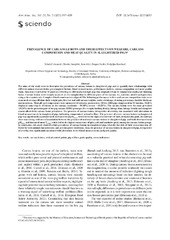Prikaz osnovnih podataka o dokumentu
Prevalence of carcass lesions and their effects on welfare, carcass composition and meat quality in slaughtered pigs
| dc.creator | Čobanović, Nikola | |
| dc.creator | Suvajdžić, Branko | |
| dc.creator | Vićić, Ivan | |
| dc.creator | Vasilev, Dragan | |
| dc.creator | Karabasil, Nedjeljko | |
| dc.date.accessioned | 2023-08-02T09:59:49Z | |
| dc.date.available | 2023-08-02T09:59:49Z | |
| dc.date.issued | 2023 | |
| dc.identifier.issn | 1642-3402 | |
| dc.identifier.uri | https://vet-erinar.vet.bg.ac.rs/handle/123456789/3048 | |
| dc.description.abstract | The aims of this study were to determine the prevalence of carcass lesions in slaughtered pigs and to quantify their relationships with different animal characteristics, pre-slaughter factors, blood measurements, performance indices, carcass composition and meat quality traits. Data was recorded for 30 journeys referring to 1080 market-weight pigs that originated from 15 commercial small-scale finishing farms. Carcass lesions were visually assessed on the slaughterline in different parts of the carcass, i.e., anterior, middle and posterior, using a three-point scale. Complete blood count was investigated. The following performance indices and carcass composition traits were measured: average lifetime daily weight gain, live, hot and cold carcass weights, cooler shrinkage, dressing percentage, backfat thickness and meatiness. Meat pH and temperature were measured 45 minutes postmortem. Of the 1080 pigs slaughtered in 30 batches, 70.28% displayed some degree of lesions on the carcass (moderate – 30.00%; severe – 40.28%). The carcass lesions were the most prevalent (50.20%) in the posterior part of the pig carcass. RYR1 genotype, live weight, loading density, lairage time, lairage density and slaughter season affected the carcass lesion prevalence. The presence of carcass lesions, irrespective of severity, was associated with alterations in blood measurements in slaughtered pigs, indicating compromised animal welfare. The presence of severe carcass lesions in slaughtered pigs was significantly associated with increased meat pH45min, which led to the highest occurrence of dark, firm and dry pork. In contrast, there was strong evidence of association between the presence of moderate carcass lesions in slaughtered pigs and both decreased meat pH45min and increased meat T45min, which led to the highest occurrence of pale, soft and exudative pork among the carcass lesion groups. In conclusion, this study showed a high prevalence of carcass lesions in slaughtered pigs, whereby the risk of their occurrence was affected by both animal characteristics and pre-slaughter conditions. Also, the presence of carcass lesions in slaughtered pigs, irrespective of severity, was significantly associated with alterations in the blood measurements and pork quality. | sr |
| dc.language.iso | en | sr |
| dc.publisher | Sciendo | sr |
| dc.relation | info:eu-repo/grantAgreement/MESTD/inst-2020/200143/RS// | sr |
| dc.rights | openAccess | sr |
| dc.rights.uri | https://creativecommons.org/licenses/by/4.0/ | |
| dc.source | Annals of Animal Science | sr |
| dc.subject | carcass lesions | sr |
| dc.subject | critical control points | sr |
| dc.subject | pig welfare | sr |
| dc.subject | pork quality | sr |
| dc.subject | stress indicators | sr |
| dc.title | Prevalence of carcass lesions and their effects on welfare, carcass composition and meat quality in slaughtered pigs | sr |
| dc.type | article | sr |
| dc.rights.license | BY | sr |
| dc.citation.volume | 23 | |
| dc.citation.issue | 2 | |
| dc.citation.spage | 597 | |
| dc.citation.epage | 619 | |
| dc.identifier.doi | 10.2478/aoas-2022-0093 | |
| dc.identifier.fulltext | http://veterinar.vet.bg.ac.rs/bitstream/id/9003/bitstream_9003.pdf | |
| dc.type.version | publishedVersion | sr |

